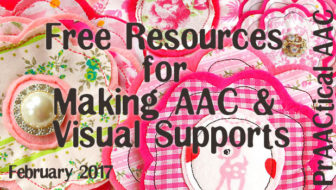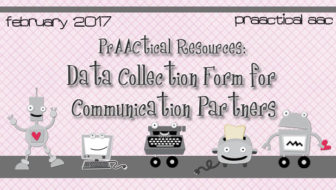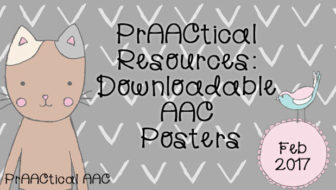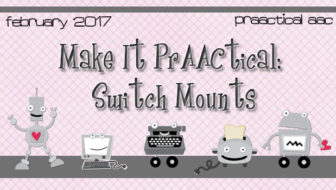February 23, 2017
by Carole Zangari -

For comprehensive AAC systems, there is no doubt that we need access to tools with the communication symbols that match our client’s needs. There are times, though, when ‘free’ and ‘simple’ fits the bill. Whether you are a graduate student clinicians/teacher, parent, or professional, these tools may come in handy. Picto4Me: This executable program works with Google Chrome and allows you to create communication boards and other visual supports at no cost. You can view and use the boards online via computer or mobile device or print them. This program offers voice output and scanning, too. ARASAAC: We’ve written about the wonderful resources at the Aragonese Portal of AAC in previous posts. Keep them in mind as you are searching for symbols or creating AAC supports. Trial versions: Some companies offer a free trial of their symbol software or programs so that consumers can try before they buy. We love... [Read More...]
Filed under: Featured Posts, PrAACtical Thinking
Tagged With: communication book, download, free
February 20, 2017
by Carole Zangari -

Last week, we posted about taking data on communication partners, something that can be very helpful when we are looking for ways to expedite the AAC user’s progress. Based on feedback from that post, we’re sharing a sample data collection form for this purpose. Do you have another idea for collecting data on the behavior of communication partners? We’d love to hear about it.
Filed under: Featured Posts, PrAACtical Thinking
Tagged With: data collection, download, forms, partners
February 19, 2017
by Carole Zangari -

Hope you had a sweet week of AAC love! Here are some posts you may have missed. Monday: PrAACtical Resources: Downloadable AAC Posters Tuesday: Happy Valentine’s Day! Wednesday: Video of the Week: Using Structure to Support Participation Thursday: Data Collection for the Beginning AAC User: Essential Things to Measure to Expedite Progress
Filed under: Featured Posts
Tagged With: summary post
February 16, 2017
by Carole Zangari -

It’s exciting to see more and more teams on the road to implementing AAC in therapy and in the classroom. Often, though, our initial expectations for student progress don’t pan out. Consider these examples. Aleksander’s SGD has robust vocabulary that is customized specifically for him. He uses it consistently at snack and lunch time, but rarely uses it in other activities. Ariel uses her AAC app to ask for things, make comments, and answer questions but rarely goes beyond the single word level to express herself. Jayson had a PECS book for over a year and learned to request his favorite foods but not much else. His team switched Jayson over to a more robust AAC system, and while he learned to communicate for other reasons, he still doesn’t use his communication book very frequently unless he’s prompted to do so. Do these situations seem vaguely familiar? Helping AAC learners become... [Read More...]
Filed under: Featured Posts, PrAACtical Thinking
Tagged With: beginning communicator, data collection
February 14, 2017
by Carole Zangari -

Show some AAC love this week! Photo credit: Roman Drits
Filed under: Featured Posts, PrAACtical Thinking
Tagged With: holiday
February 13, 2017
by Carole Zangari -

Looking for some additional AAC-related resources? CALL Scotland has some wonderful resources that can be displayed as posters, and/or used as handouts for meetings/trainings (click here). Here’s a sampling of what you’ll find. And don’t miss this interactive flyer that takes you to PowerPoint books. ‘Thanks to the wonderful team at CALL Scotland for making and sharing these terrific resources.
Filed under: Featured Posts, PrAACtical Thinking
Tagged With: AAC apps, Android, download, eye gaze, resources
February 12, 2017
by Carole Zangari -

Happy Valentine’s Day, prAACtical friends! Hope there’s a lot of AAC love in your week. Monday: Make it PrAACtical: Switch Mounts Wednesday: Video of the Week: Designing & Using Visual Supports for Older Students Thursday: PrAACtically Valentine’s Day: Core Vocabulary Activities
Filed under: Featured Posts
Tagged With: summary post
February 9, 2017
by Carole Zangari -

Looking for ways to build fluency with core vocabulary as you prepare for Valentine’s Day festivities? Here are a few suggestions. Making Cards: Get your crafting on and make some cards, like these from Christine Dunbar. Core word practice: pronouns (I, you, it, they); verbs (do, make, get, help, like); descriptors (pink, little, some), prepositions (on), determiners (this, that, these, those); interrogatives (what, where) Deliver the Cards: Have some fun being a mail carrier, delivering Valentine cards, and interacting with all the recipients. We love this mini schedule by the Considerate Classroom. Core word practice: pronouns (I, you, it, we); action verbs (go, give, get, see, take); locatives (here, there); social words (hi, thank you); determiners (this, these); interrogatives (who, where) Play Valentine Bingo: Thanks, Katie Millican and Jessica Maldonado! Core word practice: pronouns (me, my, he, she); verbs (can, have, need, get, want, play); descriptors (big, round, red); interrogatives (where,... [Read More...]
Filed under: Featured Posts, PrAACtical Thinking
Tagged With: holiday
February 6, 2017
by Carole Zangari -

If you haven’t been following the AT Makers movement, you might want to check out the wonderful projects and activities of this group. In this post, founder Bill Binko shows us how to use 3-D printing to adapt camera mounts for switches to make an affordable solution for those with access difficulties. Wait, what? You don’t have a 3-D printer? We love Bill’s suggestion of collaborating with robotics clubs and STEM groups at local high schools, scouting organizations, or community agencies who have the skills and equipment to make this happen. They are usually quite receptive to projects that help others. The design for this adaptation is shared freely with a Creative Commons/Attribution/Share license, making it a great project for students, church groups, scouts, and others. If you give this a try, be sure to go to their Facebook page to share your project. Tag us so we can see what... [Read More...]
Filed under: Featured Posts, PrAACtical Thinking
Tagged With: access, assistive technology, DIY, makers, mounting, switch
February 5, 2017
by Carole Zangari -

Happy February, all! Anyone interested in some online AAC conversation? I’m looking forward to connecting with AAC stakeholders from around the world this Thursday on Twitter, as I host the #USSAACchat (Feb 9, 7:00 pm ET). Our topic is ‘Beyond Awareness: Building a Culture of AAC Support.’ All are welcome! If you are new to Twitter or Twitter Chats or just don’t ‘get’ how it can support professional growth, you can learn more about that here. Even if you are an infrequent Twitter user, or if you are more of a lurker than a participant, we welcome you to join us. Lots of AAC in your busy week? Here are some posts you may have missed. Monday: PrAACtically February: Resources for A Year of Core Vocabulary Words Wednesday: Video of the Week: Mobilizing the Power Of Special Interests Thursday: Privacy and AAC: A Few Reflections
Filed under: Featured Posts
Tagged With: summary post









